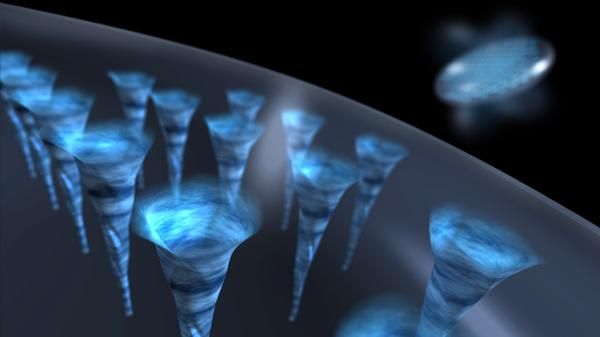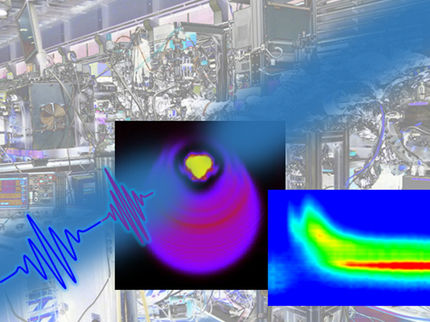Nanodroplets rotate faster than expected
Scientists observe quantum vortices in cold helium droplets
An international research team including DESY scientists has observed tiny quantum vortices in cold droplets of liquid helium. The team reports in the journal Science that the exotic vortices arrange themselves as densely packed lattices inside the nanodroplets. It is the first time that the quantum vortices, which have already been observed in larger samples of what is known as superfluid helium, have been detected in nanodroplets. “The experiment has exceeded our best expectations,”says Andrey Vilesov of the University of Southern California, one of the experiment’s three leads.

Artist's concept of the array of quantum vortices in a superfluid droplet.
SLAC National Accelerator Laboratory
The noble gas helium becomes liquid at minus 269 degrees Celsius. Below minus 271 degrees a quantum effect occurs, through which the liquid helium loses all internal friction and becomes superfluid. In this exotic state it can even crawl up walls. To explore the dynamics of superfluid helium, the scientists X-rayed tiny helium nanodroplets with what is currently the world’s strongest X-ray laser, the Linac Coherent Light Source LCLS at the SLAC National Accelerator Laboratory in California.
The production of the cold droplets with an average of only 0.2 to 2 thousandths of a millimetre was no easy task. The scientists sprayed the liquid helium through a fine nozzle into a vacuum chamber. A portion of the helium evaporated on the way, and the remaining portion of the drop continued cooling due to evaporative cooling. “After a distance of few millimeters, the drops reached the superfluid state and were struck by the intense X-ray laserflashfurther downstream,” explains DESY scientist Daniel Rolles of the Center for Free-Electron Laser Science CFEL, a joint facility run by DESY, the University of Hamburg and the Max-Planck Society.
An especially detailed recording of the X-ray scattering patterns of the nanodroplets was made possible using the CAMP experimental vacuum chamber, developed by a Max Planck group in Hamburg at CFEL. “CAMP has two large detectors that can even register individual photons and can determine their energy very precisely," stresses Benjamin Erk of CFEL. “The detectors create a series of 120 images per second while doing so.”
“The analyses of the images shows that a surprising number of drops were not spherical as expected, but were pulled length-wise by rapid rotation,” says Rolles. “In fact, some drops possessed more of a shape resembling a thick wheel with two almost parallel sides.” The rotation stems from the expansion of the liquid helium inside the nozzle, through which they enter the experimental chamber. The droplets rotated up to fourteen million times per second –far faster than a normal round drop could withstand according to the laws of classical physics.
Due to the rapid rotation, tiny “quantum vortices” formed within the nanodroplets, reminiscent of a miniature whirlpool swirling around a bathtub drain. This phenomenon had already been observed in larger units of superfluid helium, but has just now been detected in nanodroplets for the first time. As observed earlier, the vortices form a regular lattice. “In nanodroplets, the quantum vortices are surprisingly 100,000 times more densely packed than in the larger samples of superfluid helium that were previously studied,”says Vilesov.
“What we have observed in this experiment is really surprising,”stresses co-lead Christopher Bostedt of SLAC. The experiment’s third co-lead, Oliver Gessner from the Lawrence Berkeley National Laboratory, adds: “Now that we have shown that we can detect and characterize quantum rotation in helium nanodroplets, it will be important to understand its origin and, ultimately, to try and control it.”
Original publication
Original publication
Organizations
Other news from the department science

Get the chemical industry in your inbox
By submitting this form you agree that LUMITOS AG will send you the newsletter(s) selected above by email. Your data will not be passed on to third parties. Your data will be stored and processed in accordance with our data protection regulations. LUMITOS may contact you by email for the purpose of advertising or market and opinion surveys. You can revoke your consent at any time without giving reasons to LUMITOS AG, Ernst-Augustin-Str. 2, 12489 Berlin, Germany or by e-mail at revoke@lumitos.com with effect for the future. In addition, each email contains a link to unsubscribe from the corresponding newsletter.


























































